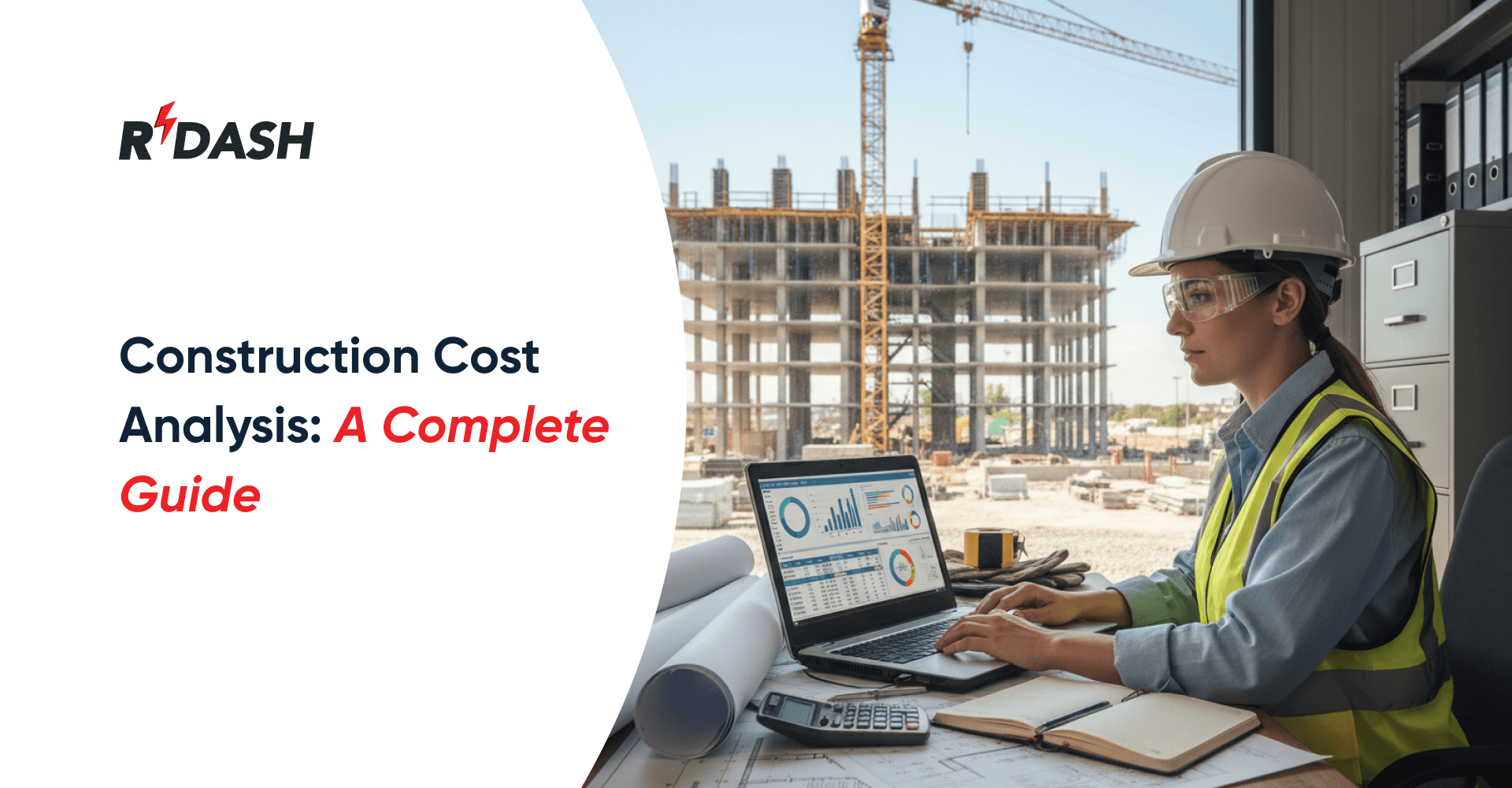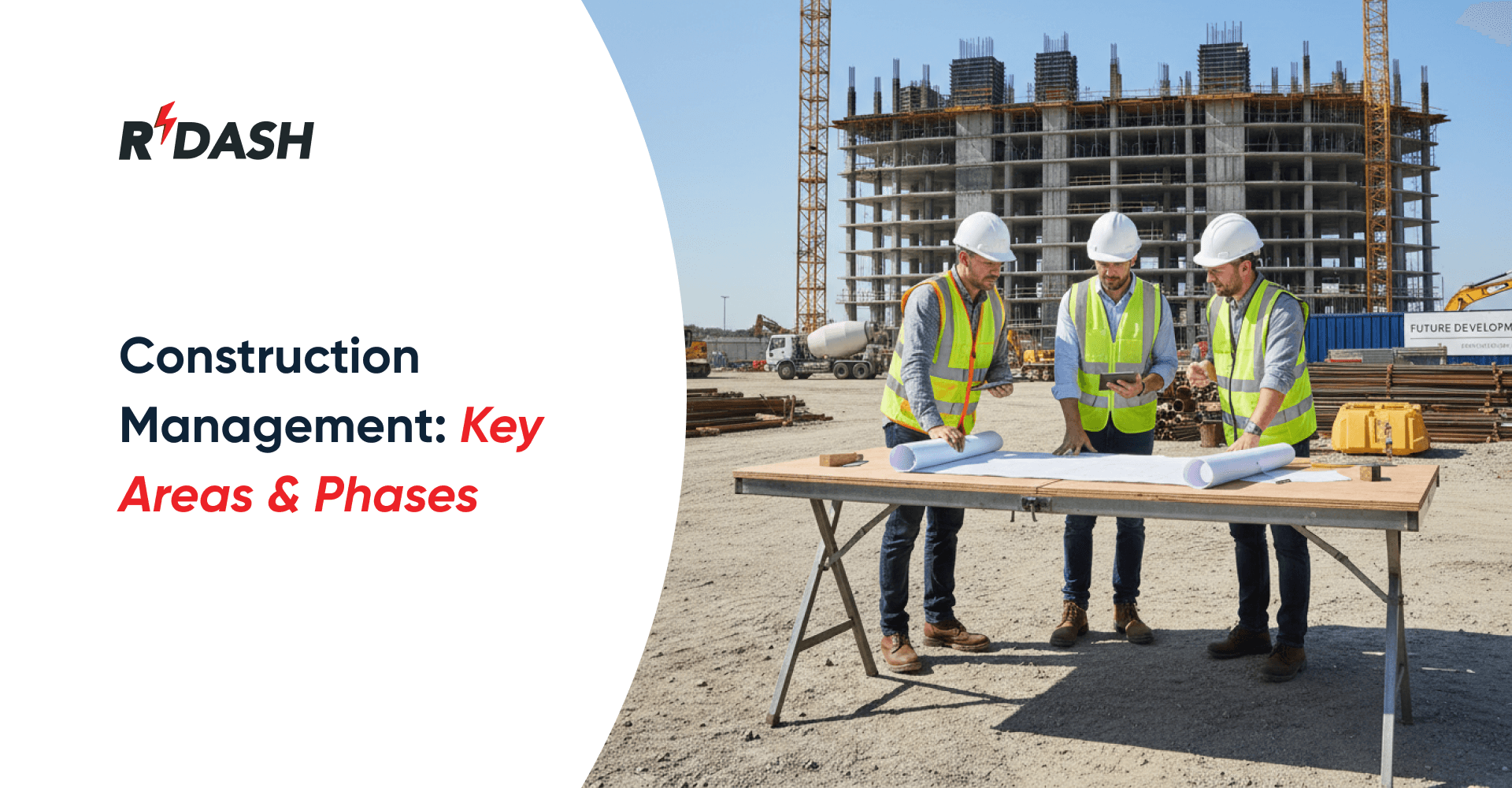Design-build projects are transforming the landscape of construction in India by streamlining processes and enhancing efficiency. This integrated approach, where a single entity handles both design and construction, offers a range of benefits but also presents unique challenges in financing and budgeting. This guide delves into effective strategies for managing finances and budgets in design-build projects, enriched with real-life examples from the Indian context.
Understanding Design-Build Project Financing
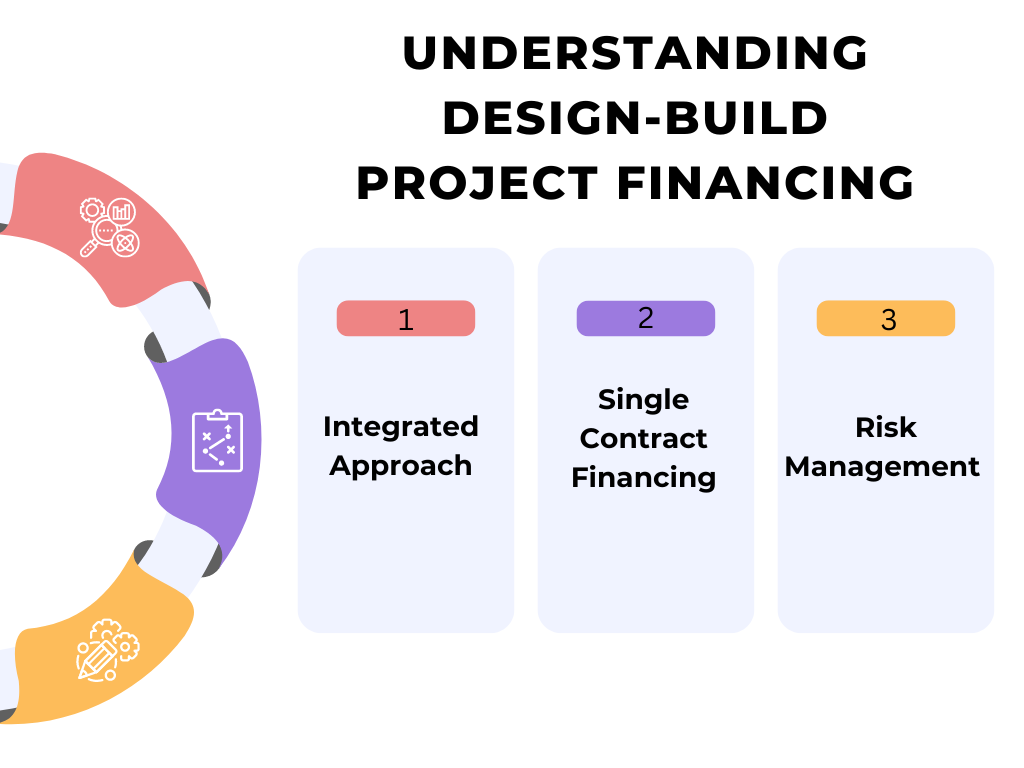
- Integrated Approach : In design-build projects, a single entity manages both design and construction, simplifying the process and often leading to more accurate cost estimates. This integration helps in reducing the number of contracts and mitigating miscommunications between parties. For instance, the development of the Delhi-Mumbai Expressway benefited from this integrated approach, allowing for smoother financial management and more precise budgeting by consolidating responsibilities under one contract.
- Single Contract Financing : Financing for design-build projects typically involves a single contract that covers both design and construction phases. This contract should detail payment schedules, milestone payments, and performance-based incentives or penalties. The Noida-Greater Noida Expressway is a prime example of a project financed through a single contract, which simplified financial arrangements and streamlined funding processes.
- Risk Management : The design-build model shares financial risks between design and construction phases. Effective risk management strategies include comprehensive insurance coverage and contingency funds. For instance, the Bangalore International Airport expansion project employed robust risk management practices, including insurance and risk reserves, to address potential cost fluctuations and unforeseen site conditions.
Building with Data: Optimizing Budgeting and Financing for Design-Build Projects
The design-build project delivery method offers a compelling alternative to traditional construction approaches. With a single point of contact for design and construction, design-build promises streamlined processes, potentially faster completion times, and improved cost control. However, navigating the financial aspects of a design-build project requires a data-driven approach to budgeting and financing.

Creating a comprehensive table on financing and budgeting for design and build projects requires gathering and summarizing data from various relevant sources. The table will include key metrics and considerations for financing, budget allocation, cost control, and financial performance. Here’s a detailed and data-rich table summarizing various aspects of financing and budgeting for design and build projects:
| Metric | Description | Average Value/Range | Source |
|---|---|---|---|
| Project Budget | Total estimated cost of the project, including all expenses. | $500,000 – $50,000,000 | Industry Reports, RSMeans, and Construction Data |
| Financing Methods | Common ways to finance the projects include loans, bonds, and equity. | Loans (50%), Bonds (30%), and equity (20%) | Construction Finance Studies |
| Interest Rates | Typical interest rates for construction loans. | 4%-8% | Federal Reserve, Industry Reports |
| Loan-to-Value (LTV) Ratio | The ratio of a loan to the value of the project. | 70% to 90% | Construction Lending Guidelines |
| Equity Contribution | Percentage of project cost covered by equity. | 10%–30% | Industry Norms, Financial Guidelines |
| Cost Overruns | Average percentage by which projects exceed their initial budget. | 10%–20% | Industry Studies, PMI Reports |
| Contingency Budget | Funds set aside to cover unexpected costs. | 5% – 15% of total budget | Project Management Best Practices |
| Soft Costs | Non-construction costs such as design, permits, and fees. | 20%–30% of total budget | Industry Reports, RSMeans |
| Hard Costs | Direct construction costs, including labor, materials, and equipment. | 70%–80% of total budget | Construction Industry Reports |
| Return on Investment (ROI) | Expected financial return from the project. | 5%–15% | Financial Planning Sources |
| Payback Period | Time it takes for the project to pay back its initial investment. | 3 – 7 years | Industry Reports, Financial Studies |
| Cash Flow Management | Techniques for managing inflow and outflow of cash during the project. | Milestone Payments, Retainage | Project Management Guidelines |
| Financial Risk Management | Strategies to mitigate financial risks in the project. | Insurance, Hedging, Diversification | Risk Management Sources |
| Value Engineering | Process of optimizing project costs without compromising quality. | 5% – 15% cost savings | Industry Best Practices |
| Project Funding Sources | Various sources of project funding such as private investors, public funds. | Private (60%), Public (30%), and PPP (10%) | Industry Reports, Government Data |
| Cost Estimation Accuracy | Degree of accuracy in initial cost estimates. | +/- 5% – 20% | Industry Studies, PMI Reports |
| Inflation Impact | Effect of inflation on project costs. | 2% – 5% annually | Economic Reports, Industry Analysis |
| Project Duration | Typical time frame from project initiation to completion. | 12 months – 36 months | Industry Reports, Project Data |
| Breakdown of Costs | Detailed breakdown of typical project costs into categories like labor, materials. | Labor (40%), Materials (30%), Equipment (10%), and Other (20%) | RSMeans, Industry Data |
Budgeting for Design-Build Projects

- Early Budget Estimation : Accurate budgeting begins with preliminary estimates based on initial design concepts and historical data. In India, factors such as regional labor rates and material costs must be considered. For example, the Mumbai Coastal Road Project required detailed early budgeting that accounted for Mumbai’s specific urban and environmental challenges, ensuring more accurate financial planning.
- Detailed Cost Breakdown : A detailed cost breakdown should include labor, materials, permits, and contingencies. Regular updates are essential to reflect changes in project scope or unexpected expenses. The Chennai Metro Rail Project illustrates the importance of meticulous cost tracking and updates to manage the complexities of urban infrastructure development.
- Contingency Planning : Allocating a contingency fund, typically 5-10% of the total budget, is crucial for addressing unforeseen costs or scope changes. The Hyderabad IT Park project utilized a well-defined contingency fund to manage unexpected challenges such as regulatory delays and material shortages, ensuring the project stayed within budget.
Financing Options for Design-Build Projects

- Traditional Loans : Traditional bank loans or lines of credit are common financing options. These loans are secured by project assets and future revenue. Major projects like the Delhi-Mumbai Expressway have been financed through conventional loans, providing the necessary capital for extensive infrastructure development.
- Project Financing : Project financing methods, such as bonds or equity investments, are suitable for larger projects. The Mumbai Metro project, for instance, utilized bonds and equity investments to meet its substantial capital requirements, demonstrating a successful approach to project financing.
- Government Grants and Incentives : Government schemes and incentives can support construction projects, especially those related to infrastructure and sustainability. The Pune Smart City project, for example, benefited from government incentives aimed at enhancing urban infrastructure, which helped reduce overall financing costs.
- Joint Ventures and Partnerships : Forming joint ventures or partnerships can provide additional capital and share financial risks. The Delhi-Meerut RRTS project, a complex transit infrastructure, exemplifies how joint ventures can effectively distribute investment and risk, leading to successful project execution.
Financial Management Throughout the Project

- Regular Financial Monitoring : A robust financial management system is essential for tracking expenditures and managing cash flow. Regular financial reviews and audits can help identify and resolve issues early. The Bangalore-Mysore Expressway project, for example, employed regular financial monitoring to keep expenditures in check and manage cash flow effectively.
- Communication with Stakeholders : Clear communication with all stakeholders, including financiers and clients, is crucial. Regular updates on financial status and budget performance facilitate informed decision-making. The Ahmedabad-Mumbai High-Speed Rail project demonstrated effective stakeholder communication, ensuring alignment and smooth project execution.
- Adjusting to Changes : Flexibility in budgeting and financing plans is necessary to address changes in project scope or unforeseen challenges. The Kochi Water Metro project adapted its budget and financial strategies in response to evolving market conditions and project needs, showcasing the importance of proactive financial management.
Documentation and Reporting
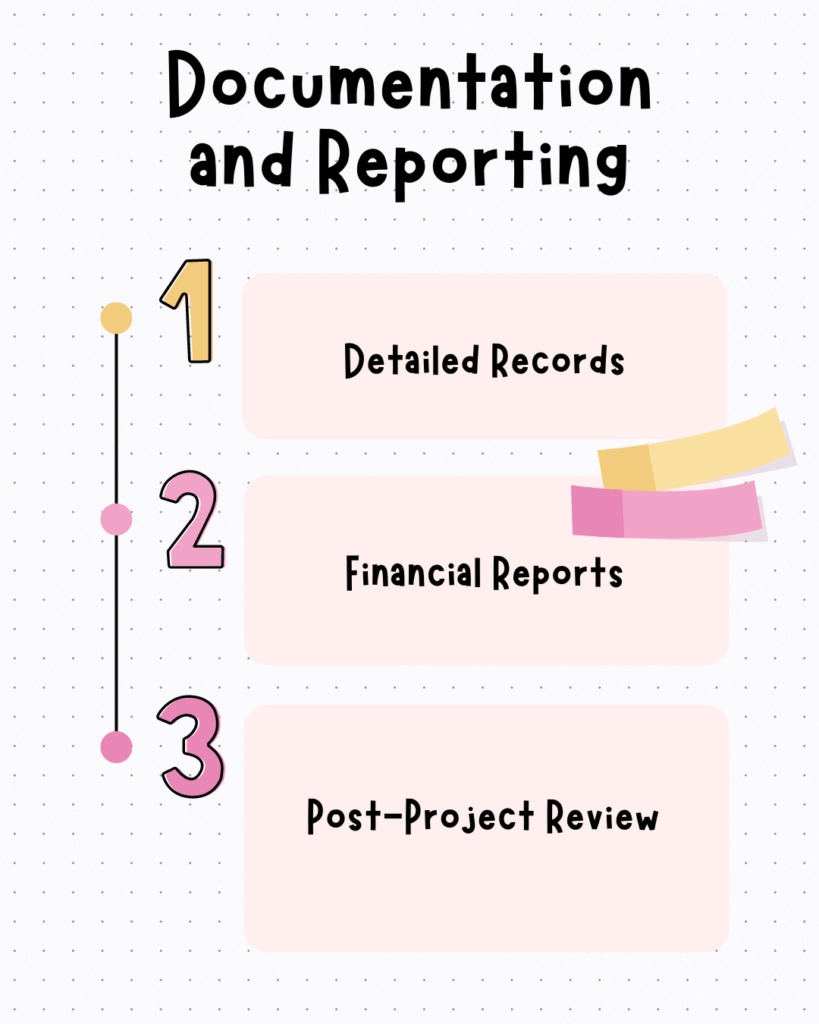
- Detailed Records : Maintaining comprehensive records of financial transactions, including invoices and contracts, is vital for transparency and auditing. The Delhi-Meerut RRTS project ensured meticulous documentation to support financial reporting and audits.
- Financial Reports : Regular financial reports provide updates on progress, budget variances, and forecasts. Detailed and clear reports are crucial for stakeholder engagement and decision-making. The Mumbai Coastal Road Project utilized detailed financial reporting to keep stakeholders informed and manage the project within budget.
- Post-Project Review : Conducting a post-project financial review helps assess overall performance, identify lessons learned, and apply insights to future projects. The Bangalore International Airport expansion project included a comprehensive financial review to evaluate success and guide future endeavors.
Addressing Key Pain Points in Construction Management with RDash
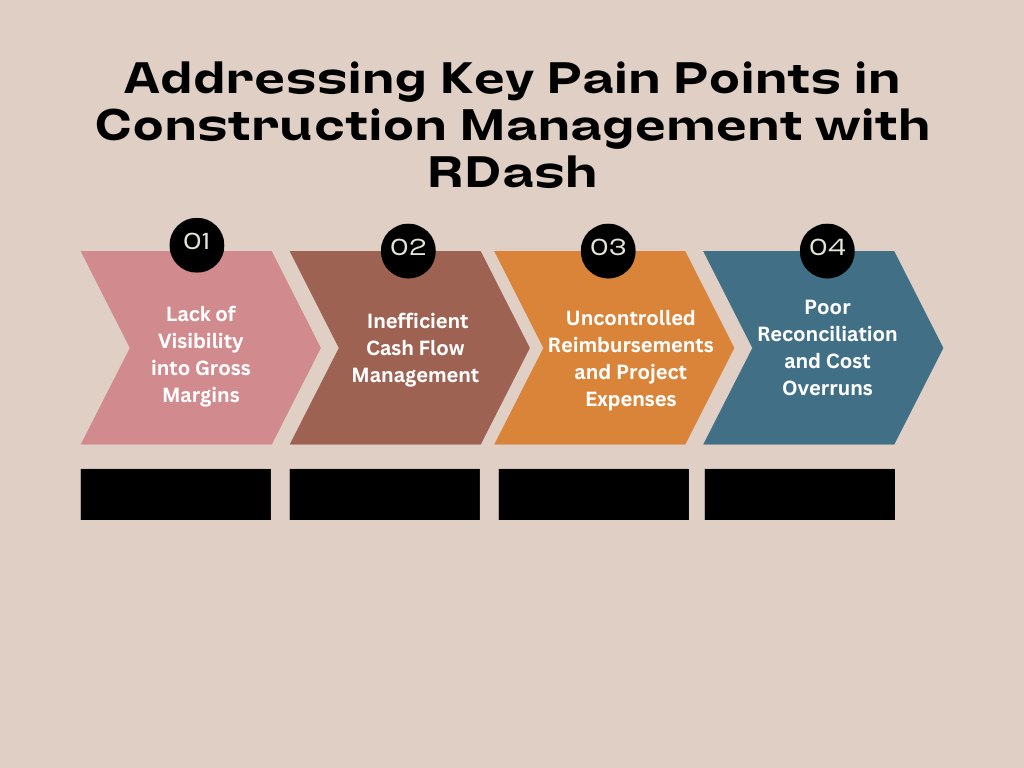
Pain Points and Remedies
1. Lack of Visibility into Gross Margins
Pain Point:
- Many contractors struggle to determine the true percentage of gross margins on their projects. Factors like changes in project scope, fluctuating material prices, unaccounted expenses, and unforeseen issues contribute to this uncertainty. Remedy:
- Assign Project Codes (JOB ID): Allocate a unique code to each project to track all related costs and revenues accurately. This helps in better margin calculation and financial visibility.
- Create a Project Wallet: Establish a dedicated cash flow wallet at the project’s start, outlining the investment based on client and supplier terms. If expenditures exceed this amount, halt further payments and escalate the issue to the client.
- Integrate ERP with Project Management Software: Ensure that financial data from ERP systems is seamlessly integrated with project management tools. This allows for real-time tracking of expenses and revenues, improving margin visibility.
2. Inefficient Cash Flow Management
Pain Point:
- Managing cash flow on projects can be challenging when payments to vendors do not align with client payments. Breaking projects into multiple suppliers and handling cash flow inefficiencies can disrupt project execution. Remedy:
- Establish a Finance Controller Bandwidth: Create a dedicated finance controller role to oversee project reimbursements and approvals. Conduct these processes on a weekly basis to maintain financial control.
- Tag Site-Specific Expenses: Ensure all expenses related to a specific site are tagged to the project’s JOB ID. This prevents unaccounted expenditures and improves cash flow management.
3. Uncontrolled Reimbursements and Project Expenses
Pain Point:
- Without a proper system for managing reimbursements and project expense limits, resolving small blockers and exigencies becomes unpredictable. This can impact client relationships and project efficiency. Remedy:
- Implement Approval Mechanisms: Develop a structured approval process for project reimbursements, with defined bandwidth and weekly review cycles. This ensures control and agility in managing project-related expenses.
- Track Executive Travel Expenses: Allocate executive travel costs directly to the project, rather than as admin expenses. This provides a clearer picture of project margins and prevents distortion of financial data.
4. Poor Reconciliation and Cost Overruns
Pain Point:
- Inadequate reconciliation processes can lead to cost overruns, malpractice, and corruption. Uncontrolled vendor payments also pose cash flow risks. Remedy:
- Ensure Proper Reconciliation: Implement a rigorous reconciliation process that involves key stakeholders, including architects, project managers, and procurement teams. This reduces the risk of cost overruns and ensures accurate financial reporting.
- Control Vendor Payments: Avoid making payments without proper documentation and approval tied to the JOB ID. This reduces the risk of cash flow issues and financial discrepancies.
By addressing these pain points and implementing the recommended remedies, RDash can enhance project management efficiency, improve financial control, and support successful scaling of construction projects.
Conclusion
Financing and budgeting for design-build projects require strategic planning and effective management. By understanding the unique aspects of design-build financing, adopting robust budgeting practices, exploring diverse financing options, and maintaining diligent financial oversight, you can achieve successful outcomes in design-build projects. The Indian construction market, with its dynamic and diverse landscape, presents both opportunities and challenges. Leveraging the insights and practices outlined in this guide will help navigate these complexities and drive successful project execution.


